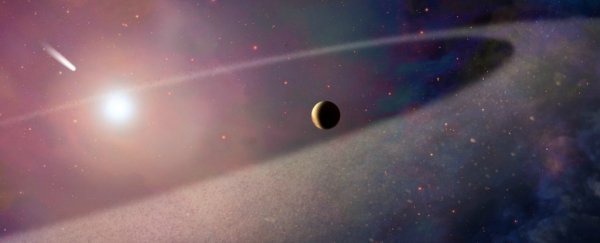Astronomers have observed something unexpectedly vicious happening in space - for the first time, researchers saw a white dwarf star ripping apart a massive, comet-like object, and scattering its remains across its atmosphere.
The destroyed object had a very similar chemical composition to Halley's comet, but was 100,000 times more massive, leading researchers to nickname it the comet's 'big brother'. And its fate wasn't pretty.
White dwarfs are incredibly dense stars that were once similar to our Sun, but have now collapsed down into their final form - a stellar object with a mass comparable to our Sun, packed into a volume similar to Earth.
This gives white dwarfs powerful tidal pull that can tear apart any objects that get too close.
And while it's not unheard of for the stars to shred rocky, asteroid-like object, this is the first time that scientists have seen it devour an object made of icy, comet-like material.
The white dwarf in question is called WD 1425+540, and it's located around 170 light-years away from us in the Herdsman, or Boötes, constellation.
The Hubble Space Telescope happened to be checking out its atmosphere, when it found evidence that an object similar to a massive comet was falling onto the star, getting ripped apart in the process.
Witnessing the brutal event, a team of researchers from NASA and the European Space Agency determined that whatever had the comet-like option had a very similar composition to Halley's comet - the famous comet that streaks past Earth every 75 years.
Both objects are rich in the elements essential for life, including carbon, oxygen, sulphur, and nitrogen - but the comet-like object that was destroyed was around 100,000 times more massive.
It was also the first nitrogen-rich object that's been seen being ripped apart by a white dwarf.
"Nitrogen is a very important element for life as we know it," said lead researcher Siyi Xu from the European Southern Observatory in Germany.
"This particular object is quite rich in nitrogen, more so than any object observed in our Solar System."
Many questions now remain about the untimely death of this 'big brother' to Halley's comet - for starters, how did it end up so close to the white dwarf in the first place?
The team suggests that the comet-like body would have formed at a distant orbit to its parent star - similar to the Kuiper belt past Neptune in our own Solar System - before being kicked onto a collision course with the white dwarf, potentially by another planet or comet in the system.
This hypothesis brings up another important question - is there a belt of icy, comet-like objects still surviving around the star?
The untimely demise of this object suggests that might be the case, and that will be the next thing the researchers look for.
The observations have yet to be published in a peer-reviewed journal, so we'll have to wait for further analysis before we get any solid answers.
But these are pretty important questions to ask, because it's thought that one day our Sun will also transition from a main sequence star into a white dwarf.
And it will help to know whether objects in the Kuiper belt, which extends past Neptune, could survive the change.
"The new findings now provide observational evidence to support the idea that icy bodies are also present in other planetary systems and have survived throughout the history of the star's evolution," a Hubble press release explains.
We'll have to wait and see if that's the case. In the meantime, let's all take a moment for Halley's comet's big brother. Its untimely demise gives us all an opportunity to learn more about how space works.
